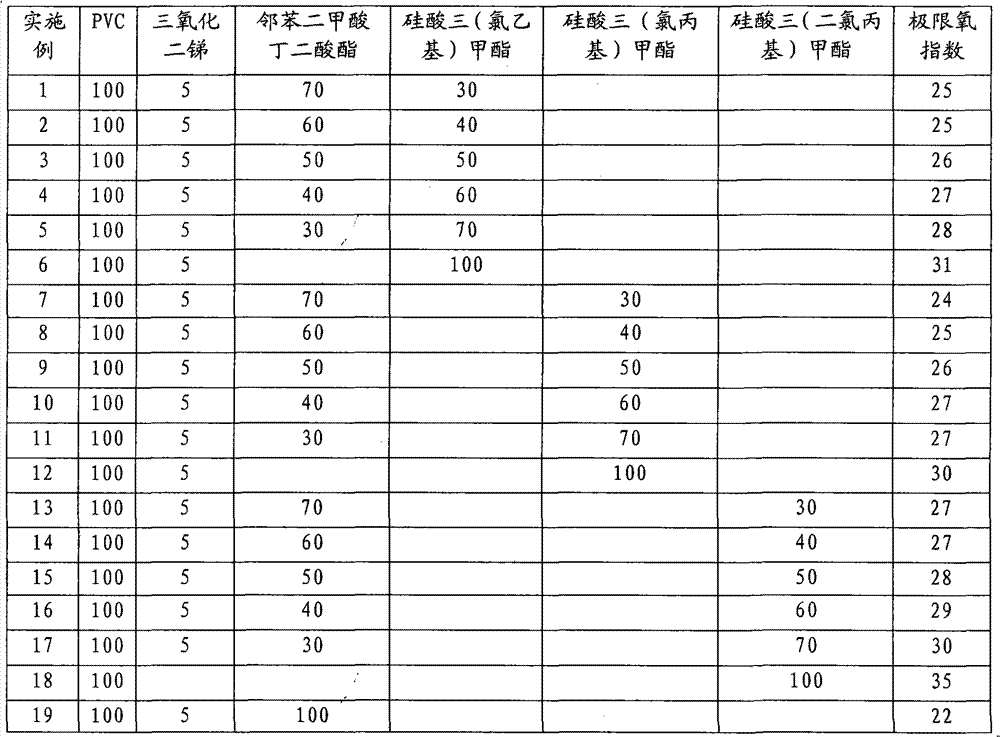Silicate ester flame-retardant plasticizer and preparation method thereof
A technology of flame retardant plasticizer and silicate, applied in the field of flame retardant plasticizer, can solve the problems of large investment and limited development, and achieve the effects of good compatibility, environmental protection and good application prospects.
- Summary
- Abstract
- Description
- Claims
- Application Information
AI Technical Summary
Problems solved by technology
Method used
Image
Examples
preparation example 1
[0024] Preparation Example 1 In a 150ml four-neck flask equipped with a stirrer, a thermometer and a high-efficiency reflux condenser, pass through nitrogen protection, add 0.1mol silicon tetrachloride, and start dropping 0.1mol methanol under the liquid surface at 20°C to react and release hydrogen chloride. After the hydrogen chloride is released, install an extremely flexible and expandable soft sealing sleeve on the mouth of the condenser, stir, and start to introduce 0.4mol ethylene oxide under the liquid surface at 20°C, cool in an ice-water bath, and control the temperature at the rate of introduction. After passing through, keep the temperature at about 30°C for another 2 hours, and then raise the temperature to 40°C for half an hour. Heat and reduce pressure to distill off excess reactants and a small amount of by-product chloroethanol and recycle them, and filter to obtain tris(chloroethyl)methyl silicate with a yield of 98%, a decomposition temperature of 224±5°C, an...
preparation example 2
[0025] Preparation Example 2 In a 150ml four-necked flask equipped with a stirrer, a thermometer and a high-efficiency reflux condenser, pass through nitrogen protection, add 0.1mol silicon tetrachloride, and start dropping 0.1mol methanol under the liquid surface at 20°C to react and release hydrogen chloride. After the hydrogen chloride is released, install an extremely flexible and expandable soft sealing sleeve on the mouth of the condenser, stir, and start to introduce 0.4mol of ethylene oxide under the liquid surface at 20°C, cool in an ice-water bath, and control the temperature at the rate of introduction , After passing through, maintain the temperature at about 20°C and react for another 2 hours. Heat and reduce pressure to distill off excess reactants and a small amount of by-product chloroethanol and recycle them, and filter to obtain tris(chloroethyl)methyl silicate. The yield is 96%, and the decomposition temperature is 224±5°C. The point (open cup) is 198±5°C, t...
preparation example 3
[0026] Preparation Example 3 In a 150ml four-neck flask equipped with a stirrer, a thermometer and a high-efficiency reflux condenser, pass through nitrogen protection, add 0.1mol silicon tetrachloride, and start dropping 0.1mol methanol under the liquid surface at 20°C to react and release hydrogen chloride. After the hydrogen chloride has been discharged, install a soft sealing sleeve that can be extremely stretched and expanded on the mouth of the condenser, stir, and start adding 0.3mol propylene oxide under the liquid surface at 20°C (gradually increase the temperature as the reaction progresses), cool in an ice-water bath, and The dropping speed controls the temperature, maintains the temperature at about 40°C and reacts for 6 hours, distills off the excess reactant and a small amount of by-product chloropropanol under reduced pressure and recycles it for use, and then filters it to obtain tris(chloropropyl)methyl silicate. Its yield is 95%, its decomposition temperature ...
PUM
| Property | Measurement | Unit |
|---|---|---|
| decomposition temperature | aaaaa | aaaaa |
| flash point | aaaaa | aaaaa |
| decomposition temperature | aaaaa | aaaaa |
Abstract
Description
Claims
Application Information
 Login to View More
Login to View More - R&D
- Intellectual Property
- Life Sciences
- Materials
- Tech Scout
- Unparalleled Data Quality
- Higher Quality Content
- 60% Fewer Hallucinations
Browse by: Latest US Patents, China's latest patents, Technical Efficacy Thesaurus, Application Domain, Technology Topic, Popular Technical Reports.
© 2025 PatSnap. All rights reserved.Legal|Privacy policy|Modern Slavery Act Transparency Statement|Sitemap|About US| Contact US: help@patsnap.com



